The Investigation of Volatile Organic Compounds (VOCs) Emissions in Environmentally Friendly Modified Asphalt
Abstract
:1. Introduction
2. Materials and Methods
2.1. Raw Materials
2.2. Asphalt Heating Emission Evaluation Method
2.3. Test Plan
3. Results and Discussion
3.1. Effects of Modifiers on VOCs Emission
3.2. The Effect of Activated Carbon Content
3.3. The Effect of Surfactant Dosage
3.4. The Effect of Temperature
3.5. Technique Properties of Environmentally Friendly Modified Asphalt
3.6. Environmentally Friendly Modified Asphalt Segregation Test
4. Conclusions
- (1)
- A simple and self-designed asphalt heating emission collection and detection device is used to detect the concentration of VOCs in the heating emission of environmentally friendly modified asphalt with different additives. The combination of activated carbon and surfactant has the best inhibitory effect on the emission of VOCs in heating emissions.
- (2)
- The overall trend of VOCs emission curves of environmentally friendly modified asphalt at different temperatures is consistent. The increase in temperature is beneficial to improving the inhibitory effect of surfactant on VOCs but has no obvious effect on the adsorption capacity of activated carbon.
- (3)
- Compared with 70# base asphalt, the penetration of the environment-friendly modified asphalt under the combination of 5% activated carbon + 3% surfactant decreased by 1.4 mm, and the softening point increased by 7.7 °C, indicating that the high-temperature stability of the asphalt was improved and the resistance to deformation was enhanced. However, the ductility of the asphalt dropped to about 15 cm, and the addition of the modifier had a certain negative impact on the low temperature performance of the asphalt.
- (4)
- Considering the inhibition effect on VOCs emission and the basic performance of environmentally friendly modified asphalt, it is suggested that the best additive combination is 5% activated carbon + 3% surfactant.
Author Contributions
Funding
Institutional Review Board Statement
Informed Consent Statement
Data Availability Statement
Conflicts of Interest
References
- Anwar, M.K.; Shah, S.A.R.; Alhazmi, H. Recycling and utilization of polymers for road construction projects: An application of the circular economy concept. Polymers 2021, 13, 1330. [Google Scholar] [CrossRef] [PubMed]
- Li, N.; Jiang, Q.; Wang, F.S.; Xie, J.; Li, Y.Y.; Li, J.S.; Wu, S.P. Emission behavior, environmental impact and priority-controlled pollutants assessment of volatile organic compounds (VOCs) during asphalt pavement construction based on laboratory experiment. J. Hazard. Mater. 2020, 398, 122904. [Google Scholar] [CrossRef] [PubMed]
- Peng, C.; Guo, C.; You, Z.P.; Xu, F.; Ma, W.B.; You, L.Y.; Li, T.J.; Zhou, L.Z.; Huang, S.F.; Ma, H.C.; et al. The effect of waste engine oil and waste polyethylene on UV aging resistance of asphalt. Polymers 2020, 12, 602. [Google Scholar] [CrossRef] [PubMed]
- Quesada, D.M.; Lagos-Varas, M.; Raposeiras, A.C.; Muoz-Caceres, Q.; Aguilar-Vidal, C. Analysis of Greenhouse Gas Emissions and the Environmental Impact of the Production of Asphalt Mixes Modified with Recycled Materials. Sustainability 2021, 13, 8081. [Google Scholar] [CrossRef]
- Li, L.; Wu, S.; Liu, G.; Cao, T.; Amirkhanian, S. Effect of organo-montmorillonite nanoclay on VOCs inhibition of bitumen. Constr. Build. Mater. 2017, 146, 429–435. [Google Scholar] [CrossRef]
- Khare, P.; Machesky, J.; Soto, R.; Presto, A.; Gentiner, D. Asphalt-related emissions are a major missing nontraditional source of secondary organic aerosol precursors. Sci. Adv. 2020, 6, eabb9785. [Google Scholar] [CrossRef]
- Wang, C.H.; Li, Q.; Wang, K.C.P.; Sun, X.L.; Wang, X.C. Emission reduction performance of modified hot mix asphalt mixtures. Adv. Mater. Sci. Eng. 2017, 2017, 2506381. [Google Scholar] [CrossRef]
- Fu, H.; Wang, C.H.; Niu, L.L.; Yang, G.L.; Liu, L.Q. Composition optimisation and performance evaluation of waterborne epoxy resin emulsified asphalt tack coat binder for pavement. Int. J. Pavement Eng. 2021, 2021, 1–15. [Google Scholar] [CrossRef]
- Schreiner, C.A. Review of mechanistic studies relevant to the potential carcinogenicity of asphalts. Regul. Toxicol. Pharmacol. 2010, 59, 270–284. [Google Scholar] [CrossRef]
- Jacopo, F.; Egidio, M.; Emanuele, T.; Michela, S.; Giorgio, L.; Cesare, T.; Giuseppe, D. Environmental and biological monitoring of occupational exposure to polynuclear aromatic hydrocarbons during highway pavement construction in Italy. Toxicol. Lett. 2018, 298, 134–140. [Google Scholar]
- Dalhat, M.A.; Al-Adham, K.; Habib, M.A. Recycling of different plastics in asphalt concrete. In Use of Recycled Plastics in Eco-Efficient Concrete; Woodhead Publishing: Sawston, UK, 2019; pp. 287–305. [Google Scholar]
- Tang, N.; Yang, K.K.; Alrefaei, Y.; Dai, J.G.; Wu, L.M.; Wang, Q. Reduce VOCs and PM emissions of warm-mix asphalt using geopolymer additives. Constr. Build. Mater. 2020, 244, 118338. [Google Scholar] [CrossRef]
- Xu, F.C.; Zhao, Y.; Li, K.J. Using Waste Plastics as Asphalt Modifier: A Review. Materials 2022, 15, 110. [Google Scholar] [CrossRef] [PubMed]
- Chen, B.; Dong, F.Q.; Yu, X.; Zhang, C.J. Evaluation of Properties and Micro-Characteristics of Waste Polyurethane/Styrene-Butadiene-Styrene Composite Modified Asphalt. Polymers 2021, 13, 2249. [Google Scholar] [CrossRef] [PubMed]
- Cui, P.Q.; Wu, S.P.; Xiao, Y.; Wan, M.; Cui, P.D. Inhibiting effect of Layered Double Hydroxides on the emissions of volatile organic compounds from bituminous materials. J. Clean. Prod. 2015, 108, 987–991. [Google Scholar] [CrossRef]
- Sukhija, M.; Saboo, N. A comprehensive review of warm mix asphalt mixtures-laboratory to field. Constr. Build. Mater. 2021, 274, 121781. [Google Scholar] [CrossRef]
- Wang, M.H.; Wang, C.H.; Huang, S.; Yuan, H.Z. Study on asphalt volatile organic compounds emission reduction: A state-of-the-art review. J. Clean. Prod. 2021, 318, 128596. [Google Scholar] [CrossRef]
- Xiao, Y.; Wan, M.; Jenkins, K.J.; Wu, S.P. Using activated carbon to reduce the volatile organic compounds from bituminous materials. J. Mater. Civil. Eng. 2017, 29, 04017166. [Google Scholar] [CrossRef]
- Huang, S.Y.; Liang, C.J. A conceptual study on the formulation of a permeable reactive pavement with activated carbon additives for controlling the fate of non-point source environmental organic contaminants. Chemosphere 2018, 193, 438–446. [Google Scholar] [CrossRef]
- Xue, Y.J.; Wei, X.T.; Zhao, H.; Wang, T.; Xiao, Y. Interaction of spent FCC catalyst and asphalt binder: Rheological properties, emission of VOCs and immobilization of metals. J. Clean. Prod. 2020, 259, 120830. [Google Scholar] [CrossRef]
- Zhang, X.Y.; Gao, B.; Creamer, A.E.; Cao, C.C.; Li, Y.C. Adsorption of VOCs onto engineered carbon materials: A review. J. Hazard. Mater. 2017, 338, 102–123. [Google Scholar] [CrossRef]
- Zhou, X.X.; Moghaddam, T.B.; Chen, M.Z.; Wu, S.P.; Adhikari, S. Biochar removes volatile organic compounds generated from asphalt. Sci. Total Environ. 2020, 745, 141096. [Google Scholar] [CrossRef] [PubMed]
- Cui, P.Q.; Wu, S.P.; Li, F.Z.; Xiao, Y.; Zhang, H.H. Investigation on using SBS and active carbon filler to reduce the VOC emission from bituminous materials. Materials 2014, 7, 6130–6143. [Google Scholar] [CrossRef] [PubMed]
- Cui, P.Q.; Zhou, H.G.; Li, C.; Wu, S.P.; Xiao, Y. Characteristics of using layered double hydroxides to reduce the VOCs from bituminous materials. Constr. Build Mater. 2016, 123, 69–77. [Google Scholar] [CrossRef]
- Cui, P.; Schito, G.; Cui, Q.B. VOC emissions from asphalt pavement and health risks to construction workers. J. Clean Prod. 2020, 244, 118757. [Google Scholar] [CrossRef]
- Li, Y.Y.; Liu, S.T.; Xue, Z.C.; Cao, W.D. Experimental research on combined effects of flame retardant and warm mixture asphalt additive on asphalt binders and bituminous mixtures. Constr. Build Mater. 2014, 54, 533–540. [Google Scholar] [CrossRef]
- Xiao, F.P.; Guo, R.; Wang, J.G. Flame retardant and its influence on the performance of asphalt—A review. Constr. Build Mater. 2019, 212, 841–861. [Google Scholar] [CrossRef]
- Li, L.H.; Zou, X.L.; Chen, C.Y. Study on oxygen index and road performance of flame retardant asphalt with combined additives added. J. Build Mater. 2013, 16, 76–80. [Google Scholar]
- Wan, Z.M.; Zheng, B.G.; Xie, X.B.; Yang, J.J.; Zhou, H.; Wan, R.S.; Wang, J.K.; Wang, J.J.; Luo, W.F.; Xue, R.; et al. Preparation method and performance test of Evotherm pre-wet treatment aluminum hydroxide type warm-mixed flame-retardant asphalt. Constr. Build Mater. 2020, 262, 120618. [Google Scholar] [CrossRef]
- RIOH. Standard Test Methods of Bitumen and Bituminous Mixtures for Highway Engineering; JTG E20-2011; Communications Press: Beijing, China, 2011. (In Chinese) [Google Scholar]
- Xia, W.J.; Zhou, X.Y.; Yang, X.Y. Suppressive effects of composite flame retardant on smoke release, combustion soot and residue constituents of asphalt mixture. J. Energy Inst. 2022, 103, 60–71. [Google Scholar] [CrossRef]
- Chang, X.W.; Xiao, Y.; Long, Y.S.; Wang, F.; You, Z.P. Temperature dependency of VOCs release characteristics of asphalt materials under varying test conditions. J. Traffic Transp. Eng. 2022, 9, 280–292. [Google Scholar] [CrossRef]
- Jamshidi, A.; Hamzah, M.O.; You, Z.P. Performance of warm mix asphalt containing Sasobit®: State-of-the-art. Constr. Build Mater. 2013, 38, 530–553. [Google Scholar] [CrossRef]
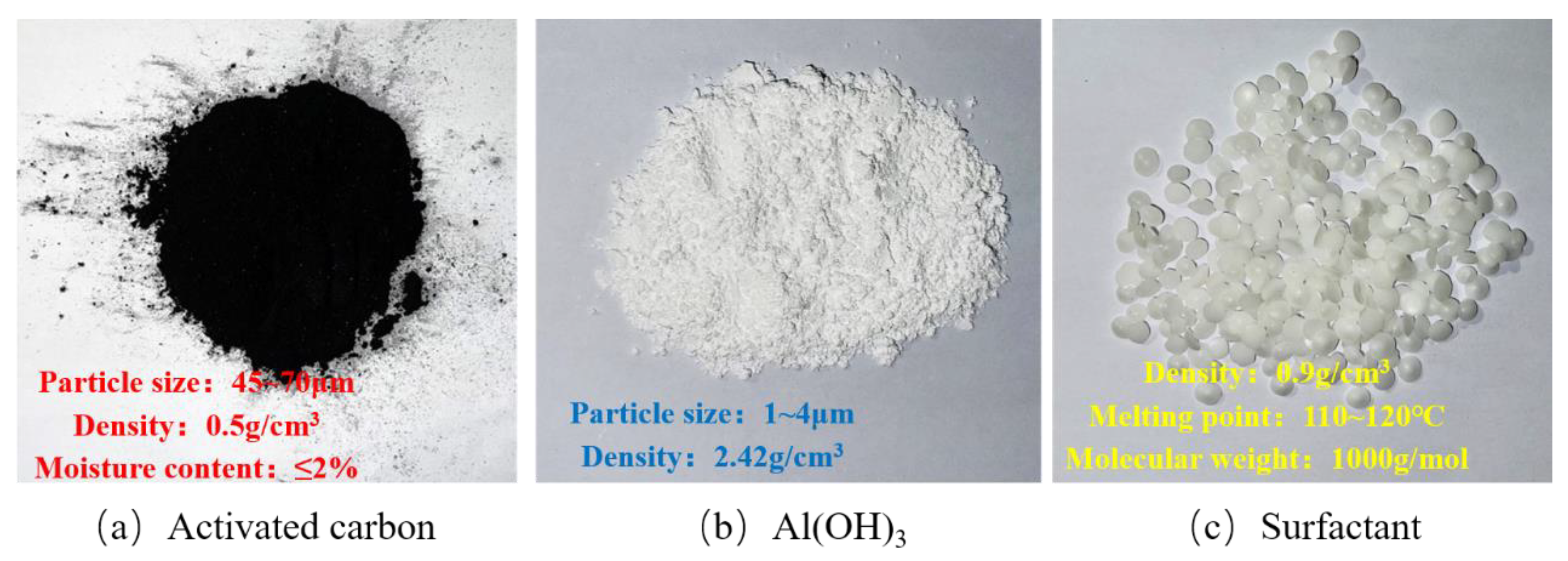
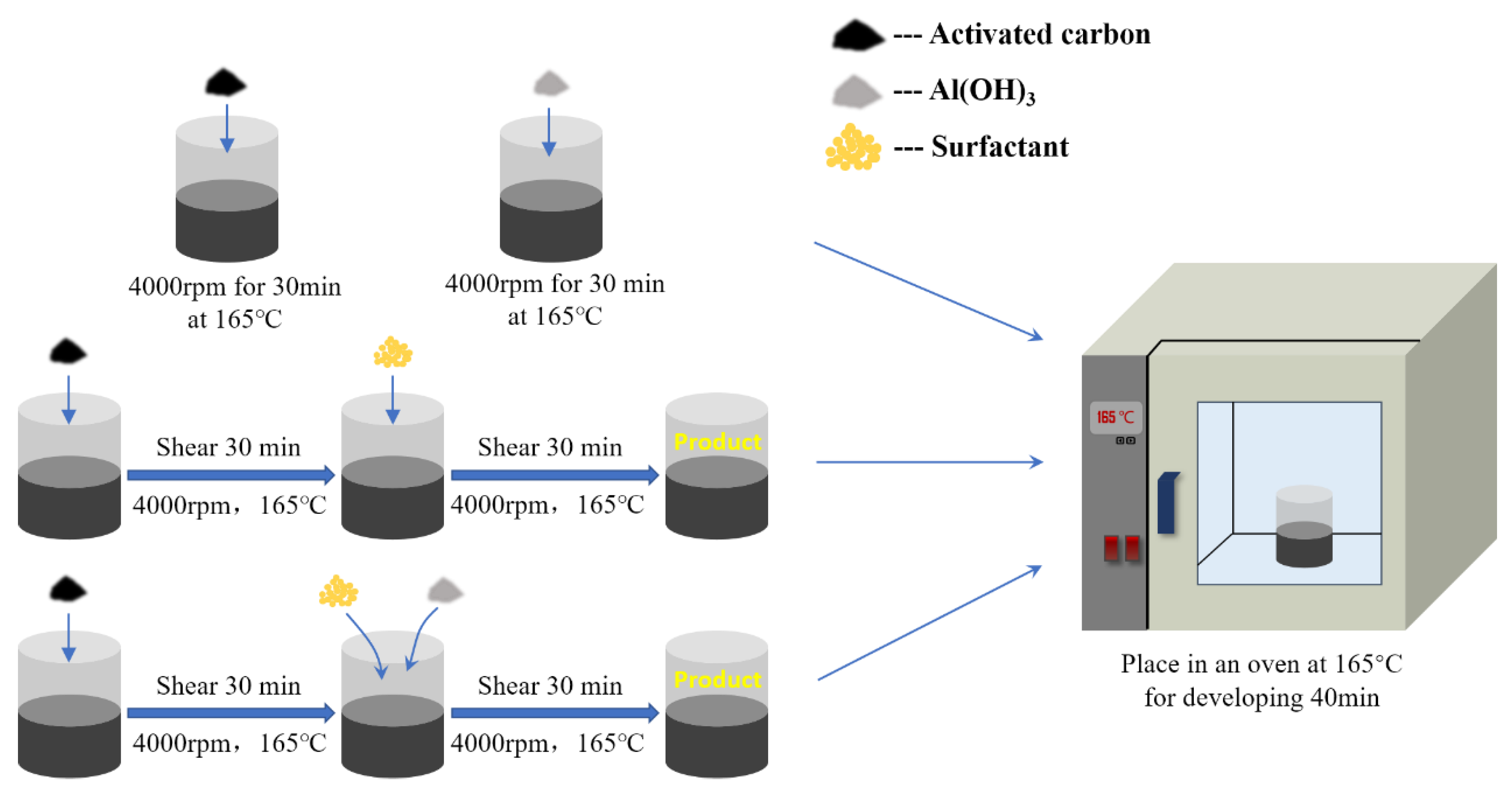
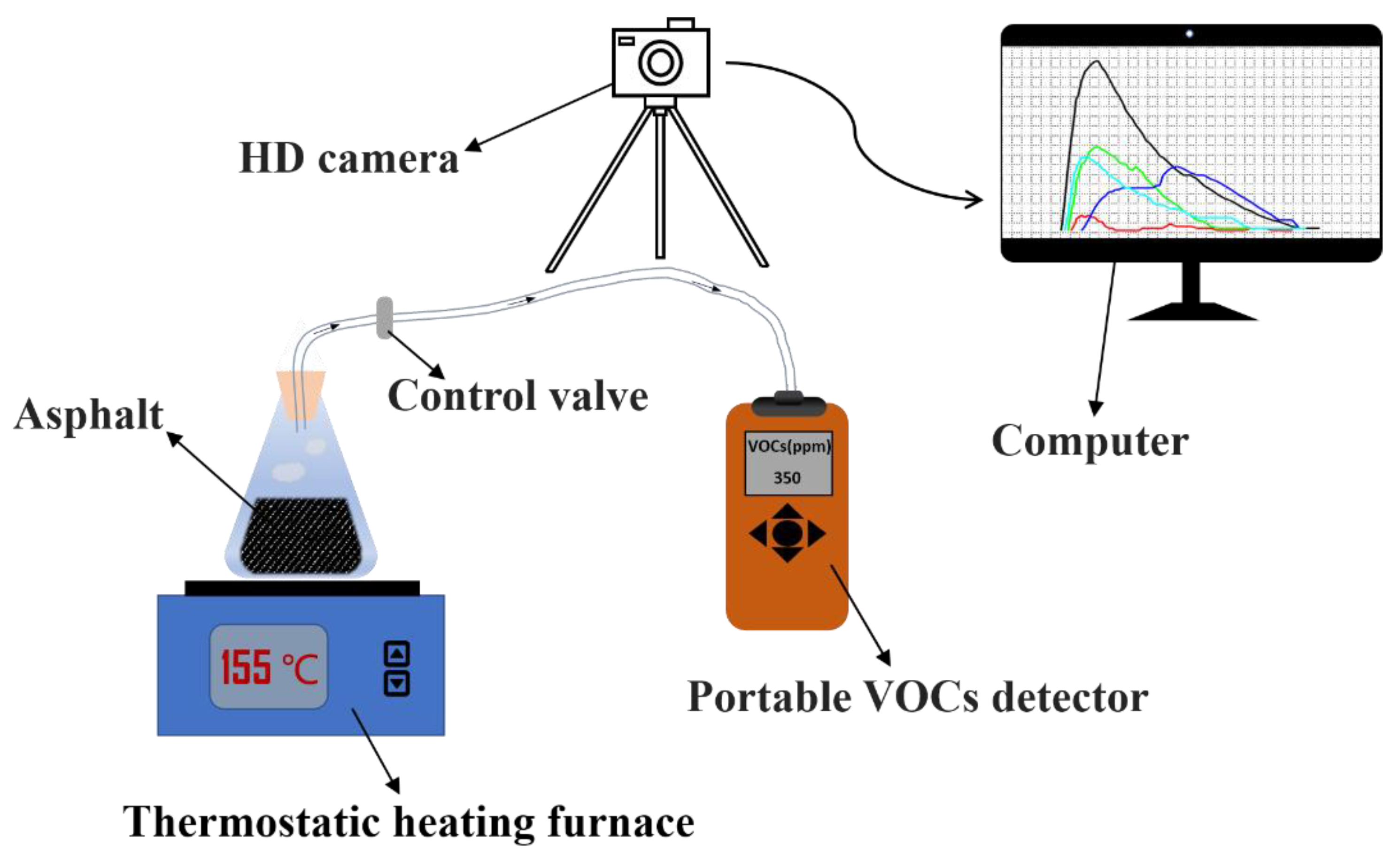

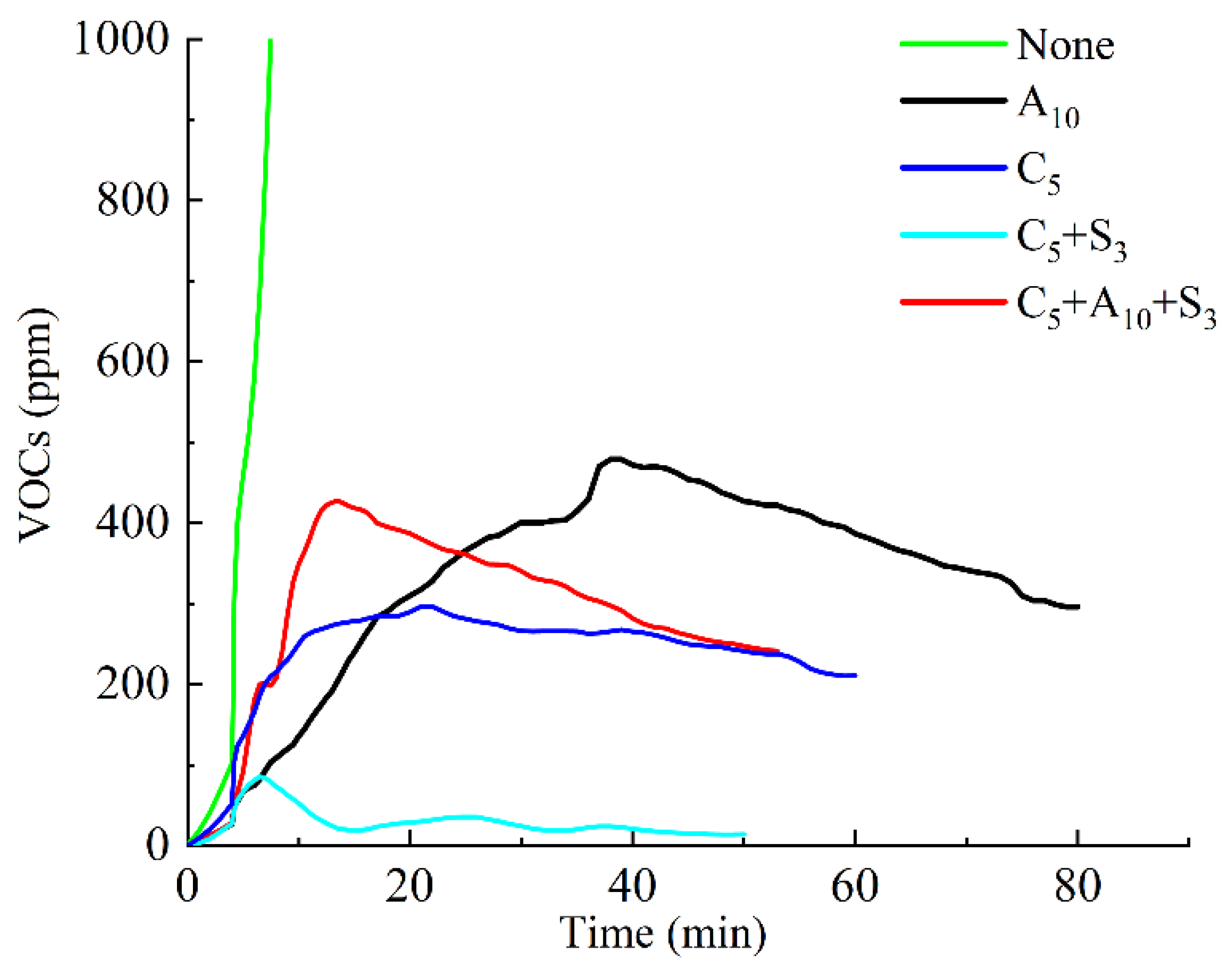
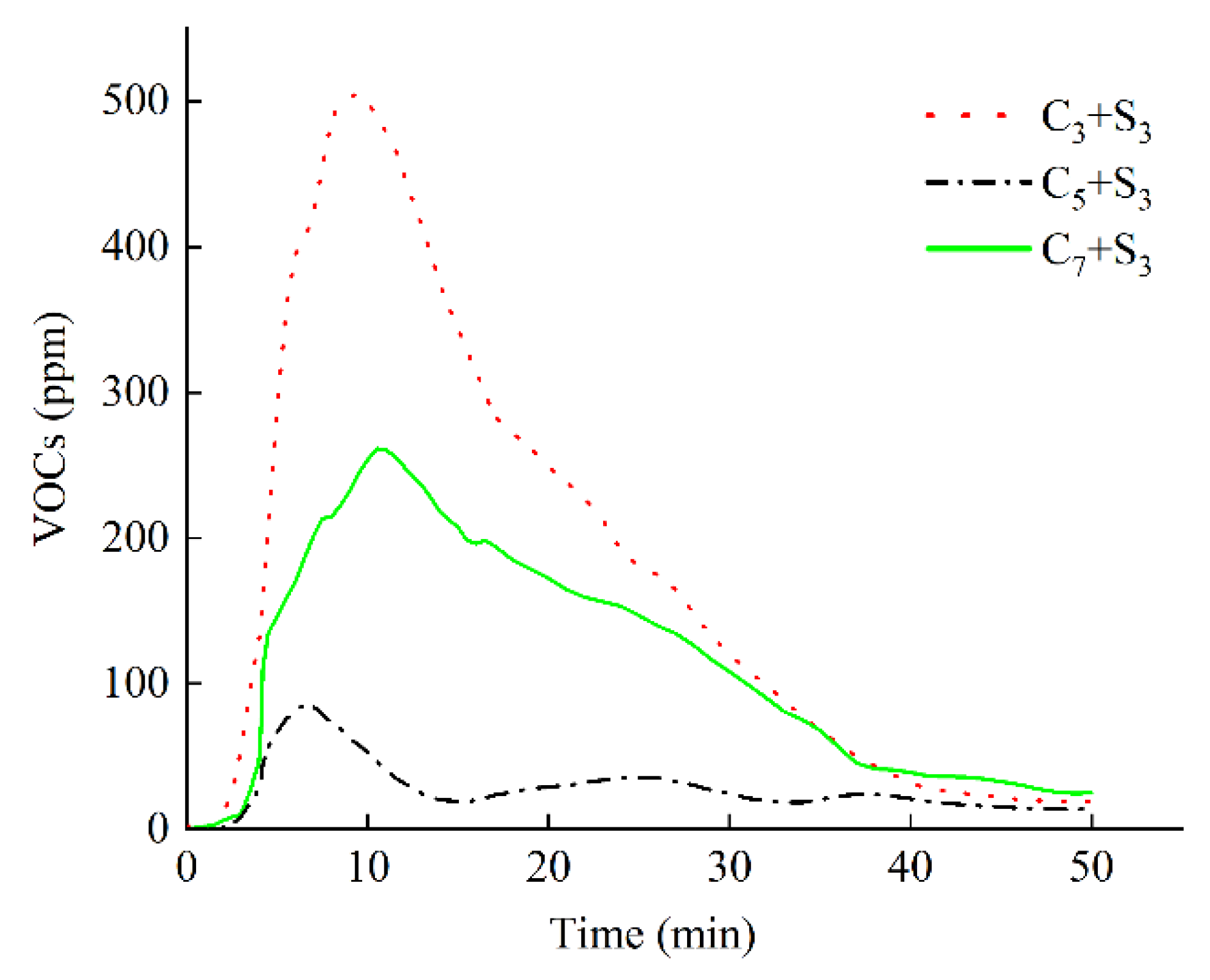
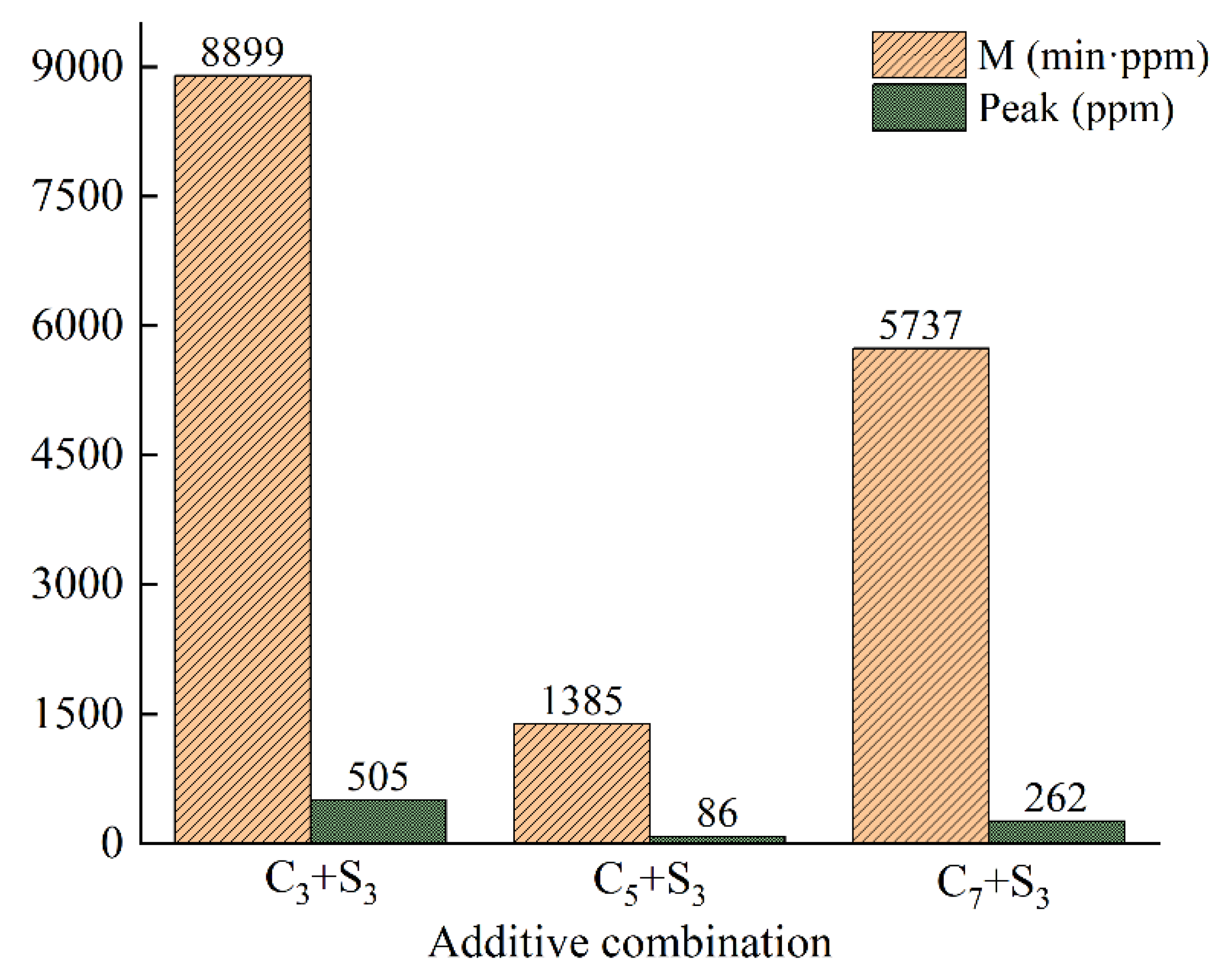
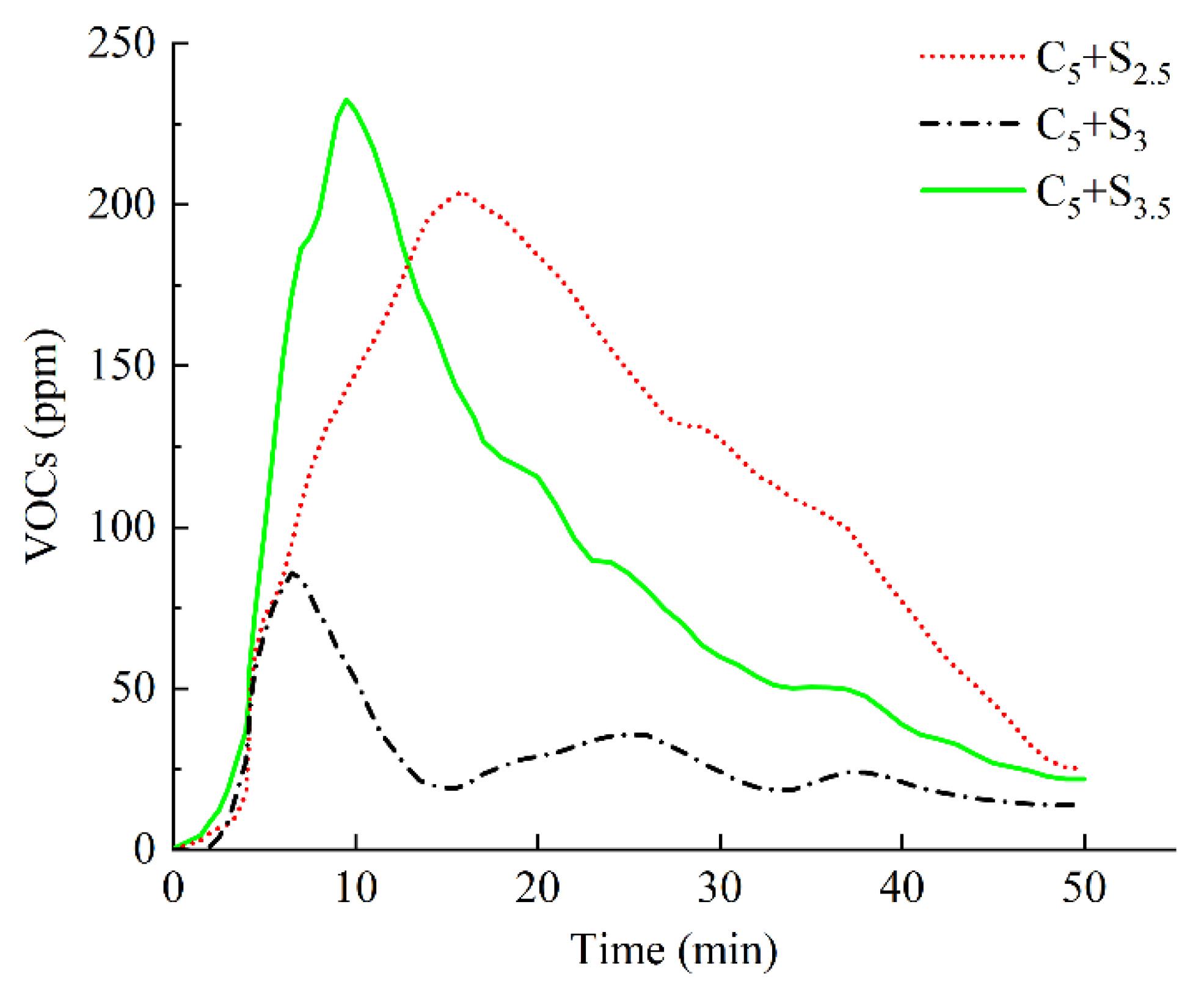
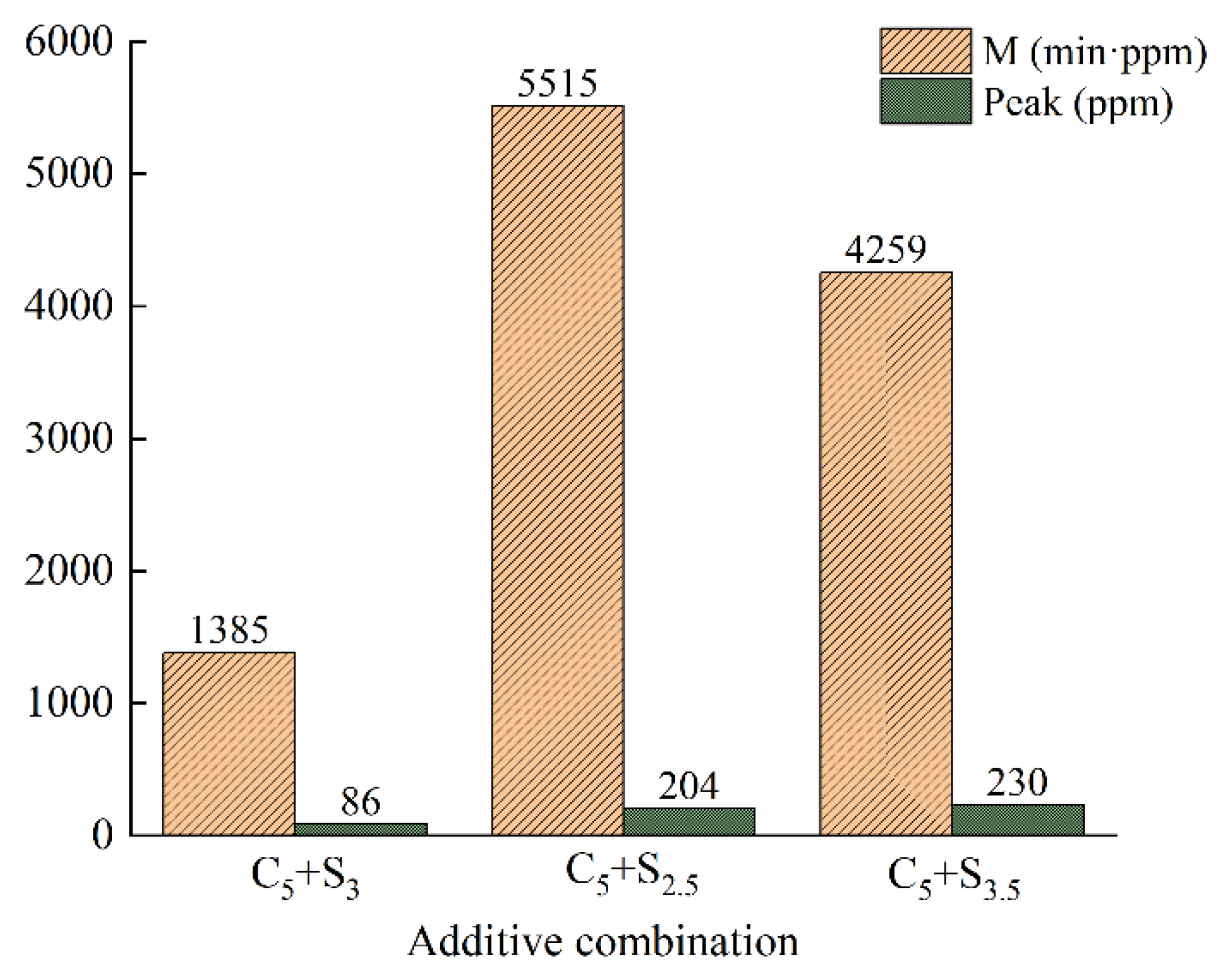



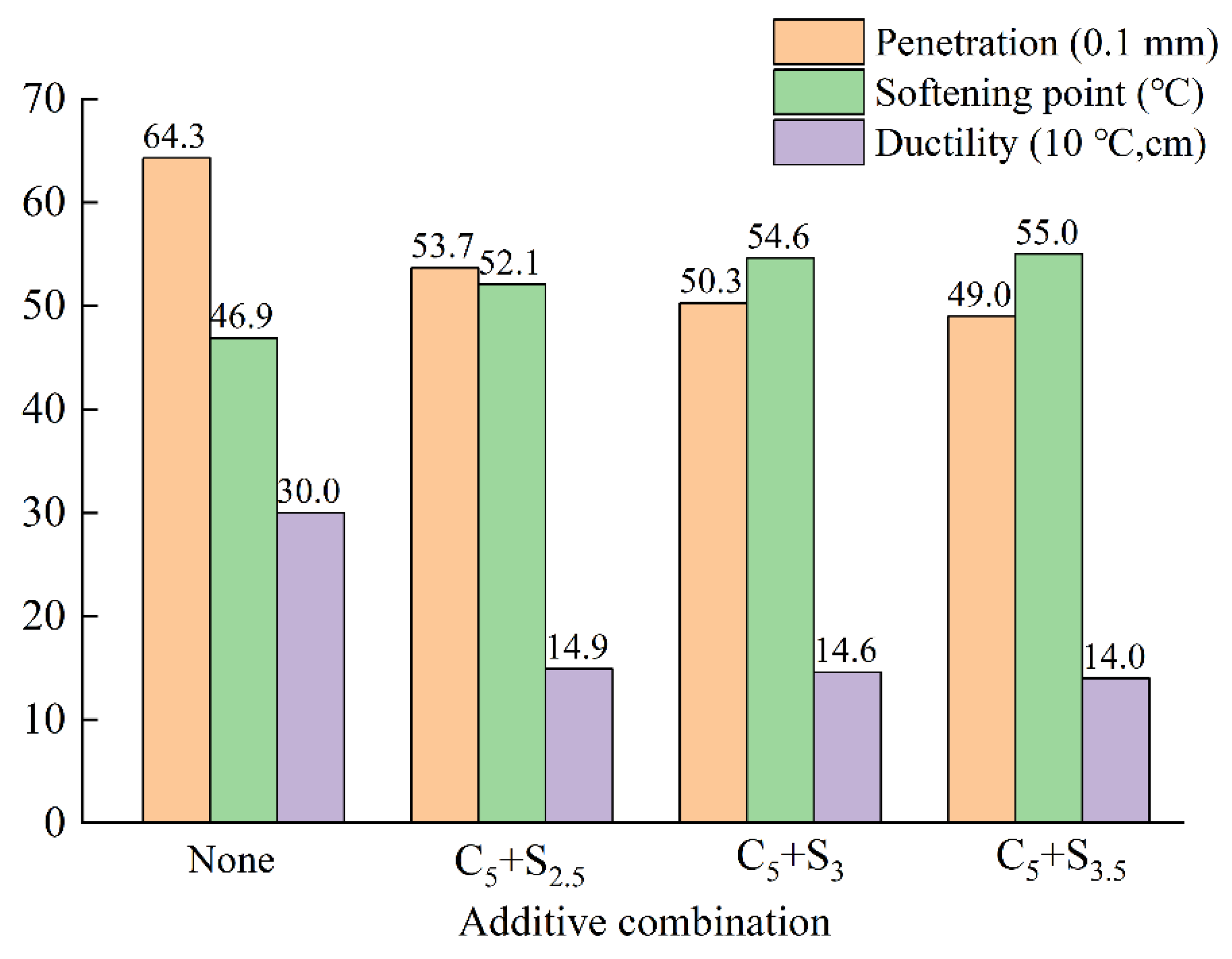
| Technical Indexes | Results | Standard |
|---|---|---|
| Penetration, 0.1 mm | 68 | T0604-2011 |
| Softening point, °C | 46.5 | T0606-2011 |
| Ductility (10 °C), cm | 25 | T0605-2011 |
| Dynamic viscosity (60 °C), Pa·s | 198 | T0620-2000 |
| After TFOT | ||
| Residual penetration ration (25 °C), % | 68.2 | T0604-2011 |
| Mass change, % | 0.04 | T0609-1993 |
| Residual ductility (10 °C), cm | 7 | T0605-2011 |
| Additive Combination | Test Temperature (°C) |
|---|---|
| None | 155 |
| C5 | 155 |
| A10 | 155 |
| C3+S3 | 135 155 175 |
| C5+S3 | |
| C7+S3 | |
| C5+S2.5 | |
| C5+S3.5 | |
| C5+A10+S3 | 155 |
| Different Dosage Combinations | None | A10 | C5 | C5+S3 | C5+A10+S3 |
|---|---|---|---|---|---|
| M (min·ppm) | ∞ | 26,276 | 14,156 | 1385 | 15,297 |
| Peak (ppm) | ≥1000 | 489 | 298 | 86 | 429 |
| Sample | Softening Point (°C) | ||
|---|---|---|---|
| Lower Part | Upper Part | Difference | |
| C3+S3 | 53.7 | 55.8 | 2.1 |
| C5+S3 | 53.9 | 56.1 | 2.2 |
| C7+S3 | 52.8 | 55.2 | 2.4 |
| C5+S2.5 | 51.7 | 53.9 | 2.2 |
| C5+S3.5 | 54.1 | 56.4 | 2.3 |
Publisher’s Note: MDPI stays neutral with regard to jurisdictional claims in published maps and institutional affiliations. |
© 2022 by the authors. Licensee MDPI, Basel, Switzerland. This article is an open access article distributed under the terms and conditions of the Creative Commons Attribution (CC BY) license (https://creativecommons.org/licenses/by/4.0/).
Share and Cite
Chen, S.; Wang, J.; Li, Q.; Zhang, W.; Yan, C. The Investigation of Volatile Organic Compounds (VOCs) Emissions in Environmentally Friendly Modified Asphalt. Polymers 2022, 14, 3459. https://doi.org/10.3390/polym14173459
Chen S, Wang J, Li Q, Zhang W, Yan C. The Investigation of Volatile Organic Compounds (VOCs) Emissions in Environmentally Friendly Modified Asphalt. Polymers. 2022; 14(17):3459. https://doi.org/10.3390/polym14173459
Chicago/Turabian StyleChen, Shuoqiu, Jiaqing Wang, Qiang Li, Wenxuan Zhang, and Chaojie Yan. 2022. "The Investigation of Volatile Organic Compounds (VOCs) Emissions in Environmentally Friendly Modified Asphalt" Polymers 14, no. 17: 3459. https://doi.org/10.3390/polym14173459
APA StyleChen, S., Wang, J., Li, Q., Zhang, W., & Yan, C. (2022). The Investigation of Volatile Organic Compounds (VOCs) Emissions in Environmentally Friendly Modified Asphalt. Polymers, 14(17), 3459. https://doi.org/10.3390/polym14173459






